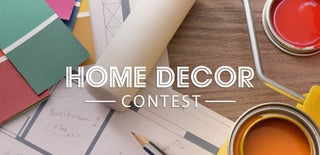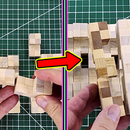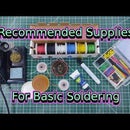Introduction: Make an Infinity Mirror Clock
In a previous project I built an infinity mirror, where my ultimate goal for it was to make it into a clock. (Make a Colorful Infinity Mirror) I didn't pursue that after building it because, although it did look cool, there were a few things with the design that I didn't like. For this project I have gone through a redesign and connected it to an Arduino, making a clock.
Some of the photos that I included have info that's not listed in the step, so check out all of the photos for all of the info for each step. Also, while building this project, there were a few times that my camera either didn't take the photos, or some of the photos got lost. If there are any steps that are unclear, please leave a comment. I will update this Instructable as necessary.
If you would rather see a video version of this Instructable, you can view that here: https://youtu.be/GZtmViBg-K4
Supplies
(Tools, parts, and supplies list is bigger than I want to admit.)
-------------
Tools
- Straight Edge Ruler
- Utility Knife
- Sharpie
- Hand Saw
- Spring Clamps
- Sanding Block
- Pencil
- Soldering Iron
- Wire Cutters
- Wire Strippers
- Dremel
- Dremel Bit #115 (Carving Cylinder)
- Dremel Bit #199 (Carving Disk)
- Dremel Bit #85422 (Grinding Stone)
- Dremel Bit #EZ406-02 (Metal Cutting Disk)
- Drill
- Drill Bit 1/16"
- Drill Bit 1/8"
- Drill Bit 3/16"
- Drill Bit 3/8"
- Square
- Angle Finder
- Tin Snips
- Pliers
- Small File
- Philips Screw Driver
- Orbital Sander
- Polishing Pads
- Microfiber Polishing Cloth
- Nylon Cutting Board
-------------
Parts
- 2 - 1/4" Square Wood Dowel, 36" Long
- 2 - Aluminum Angle Bar, 1/2"x3/4"x1/16", 36" Long
- 6 - Coupling Nut, #10-24 x 3/4"
- 6 - Bolts, #10-24 x 1" 1" x 1/2"
- Wood Board (minimum length 9.5 inches)
- 1 - Bolt 1/4"-20 x 1"
- 60 - Addressible LEDs
- Wire
- LED Wire Connectors
- LED Controller (IR Remote)
- LED Controller (Bluetooth)
- LED 5v Power Supply
- Plexiglass (minimum 10.5" x 10.5")
- Aluminum Sheet Metal (minimum 10.5" x 10.5")
- Semi-Reflective Film
- Threaded Insert 1/4"-20 x 13mm
- Arduino Nano
- 2 - Touch Sensors
- Barrel Plug
-------------
Supplies
- Painters Tape
- Wood Glue
- 60 Grit Sandpaper
- 220 Grit Sandpaper
- Solder
- Solder Flux
- Random Wood Block (150 degree angle)
- Epoxy Putty
- Film Spray
- WD40
- Black Duct Tape
- Chrome Color Paint
-------------
Step 1: Build the Wood Frame: Layer 1
I made a template for the pieces of the wood part of the frame. I cut out one and traced it onto a 1/4" square dowel, then cut the dowel at my marks. The wood frame has 2 layers and each layer needs 12 of these pieces, so I cut 24 of these pieces from the dowel. Each piece is about 73mm from tip to tip, and the angle is 30 degrees.
I want to position these so that the angle of one will be glued to the bottom of the next one. Check out the picture to see what I mean. I use another template to help me position these as I glue them together, and tape the pieces to the template with painters tape. I glue 12 of these pieces together like this into a circular form, then I let the glue dry.
Step 2: Build the Wood Frame: Layer 2
I use the other 12 pieces for the second layer. I lost the pictures for this part of the process, so I'll show the results. I didn't use a template to create the second layer, I just glued the pieces directly onto the back of the first layer, and held them together with clamps. If you look at the pictures I have of the joints, you'll see that the two layers are offset so that the layers support each other. You'll also notice that the pieces go beyond the frame. I did this so that I can sand them smooth and so that they fit together perfectly.
Step 3: Attach the LEDs
The LEDs that I used are individually addressable, and they are from an LED strip. I cut the strip apart at all of the cutting points because I wanted the lights to be closer together than they were on the strip. I attach them 1 segment at a time with LEDs at each corner joint and 4 LEDs between each corner.
I loosely position the LEDs for the next segment, then using a pencil with a sharp tip I mark the frame between the LEDs and at the ends of the LEDs. The place at the ends that I mark are where I carved away the wood for the wires go. I also did the same for the backside of the frame where the wires are going from one LED to the next.
Step 4: Solder the LEDs Together
When I solder the LEDs together, I do them one by one. I position it using the marks that I made earlier, then fold the ends down into the groove that I carved out. Before soldering the wires to the LED I apply a bit of flux, then solder, to the wires and copper pads so that it's easier to solder them together. I solder a red wire to the 5+ copper pad, green to the data pad, then white to the ground pad. I used these colors just because they match the wires I used for the wire connectors.
Before wrapping the wires around the wood frame, I pre-bend them so that they don't misalign the LED that they are soldered to. I pre-bend them by holding the copper pads in place with my thumb then just bending each wire one by one. Then they are ready to wrap around the frame. Now I can cut off the excess wire and solder them to the next LED.
I continue this process all of the way around the wood frame. On the last LED I connected the 5+ and ground wires to the first LED, but didn't connect the data wire. On the first LED I have the input copper pads soldered to an LED connector.
Step 5: Test the LEDs
I connect the ring of LEDs to an LED controller to test them out. This is important in case there are any bad LEDs or bad solder points. Only about half of the lights are lighting up, so I power off the lights and examine the LEDs in the area where they stopped lighting up. I could see that the data pad on one of the LEDs had been pulled off so I replaced that LED. I tested the lights again, and they all lit up.
Step 6: Shaping the Aluminum Frame
Now on to the aluminum frame. Using an angle bar (size is on the picture) I make marks every 67mm. These marks are where I want to bend it. At each mark I drill a 1/16" hole, then I mark a 30 degree angle at each hole. I cut out this angle with tin snips, then wherever the cutting bent the metal I straightened it with pliers.
Using a wood block that I cut a 150 degree angle, I use the wood block to help me bend the corners at the marks I made earlier. This alone didn't get the corners to stay bent at 150 degrees, so I use another template to help me adjust the bend by hand.
The aluminum frame has 2 pieces to it, front and back. I repeat the process in this step for both pieces of the metal frame.
Step 7: Bonding the Aluminum Frame
I take both of the pieces that I just bent, and tape them together in the positions they will be when complete. I make sure to position the open ends of each piece on opposite sides of the frame. I use some epoxy putty to fill in the gaps at each of the corners, and to bond the open ends together. Also at the ends (but NOT at each corner) I make sure to add extra epoxy to the inside surfaces to make sure it holds together strong. DO NOT epoxy the front piece to the back piece.
After the epoxy sets, I remove the tape. I file and sand the epoxy at each of the corners until it is smooth with the rest of the surface.
Step 8: Mount/Attach the Bolts to the Frame
To hold the front of the frame to the back, we obviously don't want to use tape permanently. Here was my solution; I took 6 coupling nuts, ground 2 sides down to make it as thin of a rectangle as I could without grinding all of the way through the threads, and put some notches into the sides. I want to epoxy these to the front piece so that I can bolt it to the back. The trick was making sure they line up perfectly, but that turned out to be fairly easy.
After deciding which piece of the frame I want to use for the back piece, I used a 1/16" drill bit to drill a hole where I wanted the 6 bolts to go, making sure not to drill these pilot holes too close to the edge. Next I drill the same holes bigger with a 1/8" drill bit, then again with a 3/16" drill bit. (I could have skipped the middle size.) Next I inserted the bolt into the hole. I put the nut on the bolt, then taped the front and back together again. I mixed some more epoxy putty, put some in the frame below the nut, then pushed the nut into the epoxy and into position. After the epoxy was set, the nuts and bolts were all perfectly aligned! I removed the bolts and the tape, then added more epoxy to the sides of the nuts. After that set, I filed the epoxy from the front surface of the nuts, except for a portion near the bottom of the nut.
Step 9: Cut and Prepare the Front Plastic
With the frame all built, it's time to finish the insides. Next lets to the front piece of plastic. I take a sheet of plexiglass and place it under the front piece of the frame, then trace around the frame. When I cut this out, I need to stay inside the line about 1/16" to compensate for the thickness of the aluminum.
After I cut out the plexiglass, I place it on the frame and mark where I need to carve it out to fit past the nuts and epoxy. After carving out those places I test fit the plastic, then adjust the carvings as necessary. Once it fits well, it's ready to put the reflective film on it.
Step 10: Cut and Prepare the Aluminum Mirror
For the aluminum, cutting it to size is similar to the plastic. Just place it under the frame, trace around it, then cut it inside the line. Where the 6 nuts are you need to cut slots out, but just big enough for the nuts and not the epoxy. Also remember that you need to cut a groove at the top for the wires to pass through.
After it's just to shape it's ready to polish. I won't go over the steps for that here, but you can check out the Instructable that I made for that process here: Polish Aluminum Sheet Metal to Mirror Finish
Just out of curiosity, I decided to add some of my reflective film to the metal, to see how that compares to the polished aluminum. In the final project, the film will be in the top half of the mirror. In my opinion, it works about the same well, so polishing my not be necessary if you use the film.
Step 11: Make the Warping Bar
To add a warping effect to the infinity mirror, I used a piece of wood that I added a threaded insert in the middle of it. With this I can have a bolt press on the backside of the aluminum mirror. This should make the infinity effect curve inwards.
Step 12: Touch-ups Before Final Assembly
With the frame all finished, I painted the metal portion a chrome color. For the wood portion with the LEDs, I added some thick, black tape to both sides, covering the solder points. Then I hot glued some scraps of plexiglass to it on the side that the aluminum will be pressing against.
Step 13: Assemble the Clock
Now it's time to put all of the parts together. And remember, the aluminum mirror has the reflective film on the top half.
When adjusting the warping bar, if it's too tight the effect will be warped in random ways. If the warping is too crazy and you just want it to curve in towards the center, just loosen the bolt in the warping bar. It doesn't need to be very tight to work well.
Step 14: And That's It!
And that's it! One thing that I didn't mention is the Arduino that I used. It's an Arduino Nano, and I'll do an Instructable specifically about setting that up for this and add a link right here when that's done.
If there is any step that needs more detail, or just isn't very clear, leave a comment and let me know. I'll update this Instructable as necessary.
If you build an Infinity Mirror Clock, I would love to see how it turns out!
Social Media:
- Twitter - https://www.twitter.com/HowDoYouDIY
- Facebook - https://www.facebook.com/HowDoYouDIY
- Instagram - https://www.instagram.com/howdoyou.diy
Step 15: Arduino Code!!
Here is a link to the code I used for the Arduino Nano. This should be a good starting point for your project. This is just basic code and will not keep the clock accurate for extended lengths of time. In order to keep it accurate, a WiFi connection will be needed or a Real Time Clock added, along with the code to use those.
GitHub: https://github.com/HowDoYouDIY/LED_Clock
I'm currently experimenting with a D1 Mini to get internet time. My GitHub link has 2 folders, and the WiFi folder has files that work with the D1 Mini to get the time from the internet. (This file version does not use touch sensors and does not support manually adjusting the time.)
If you find any issues with this code, please let me know so that I can fix this page. Or if you add any improvements, I would love to see what you add.

Participated in the
Home Decor Contest













